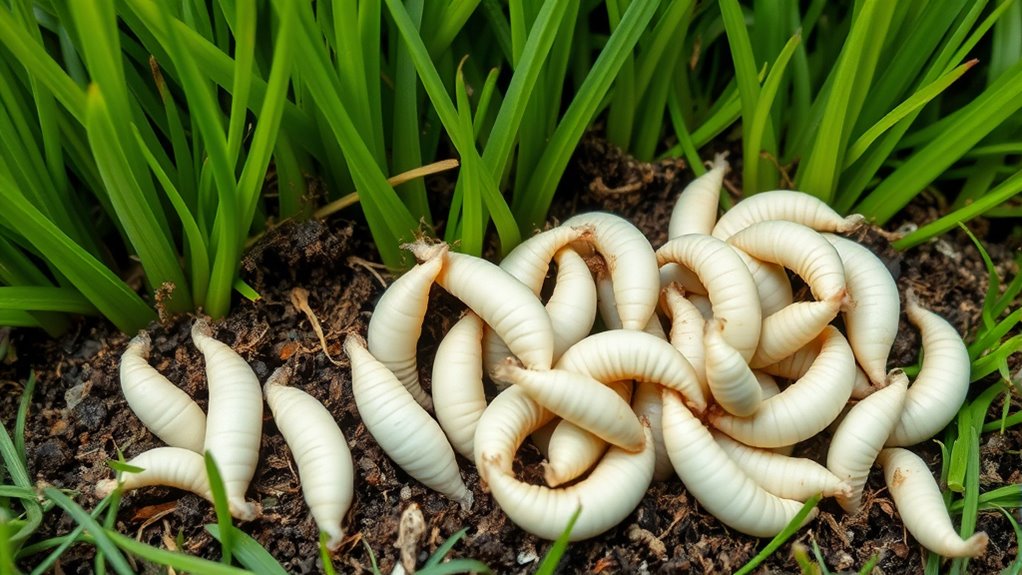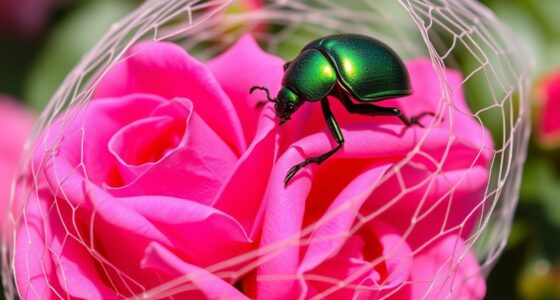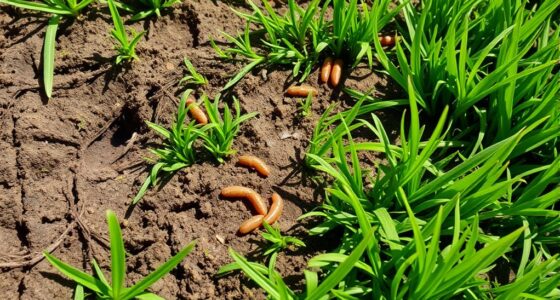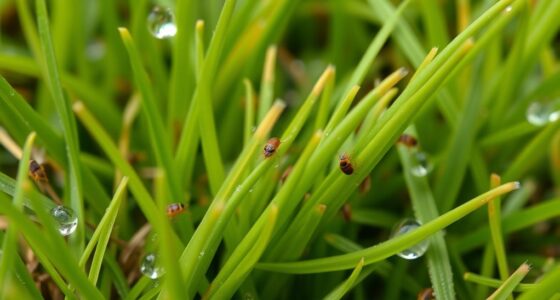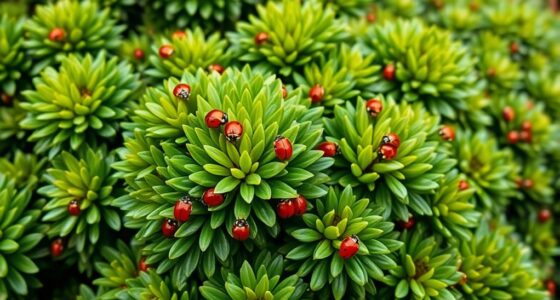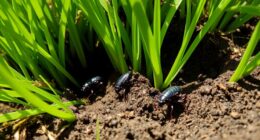If you notice brown, thinning patches of grass or birds and skunks digging in your lawn, you might have white grubs. These larvae are C-shaped, creamy-white, with brown heads, and sit just below the soil surface, feeding on roots. Their presence can weaken your turf, leading to damage and patchy areas. To learn how to identify them accurately and control infestations naturally, keep exploring more effective, eco-friendly strategies.
Key Takeaways
- White grubs are C-shaped, creamy-white larvae with brown heads, typically 0.5 to 1 inch long, found in the topsoil.
- Signs include brown patches, thinning grass, and turf damage caused by larvae feeding on roots.
- Birds like starlings and blackbirds naturally feed on grubs, helping control their populations.
- Applying beneficial nematodes targets and kills grubs biologically without harming the lawn.
- Cultural practices such as aeration, proper fertilization, and deep watering prevent grub infestations.
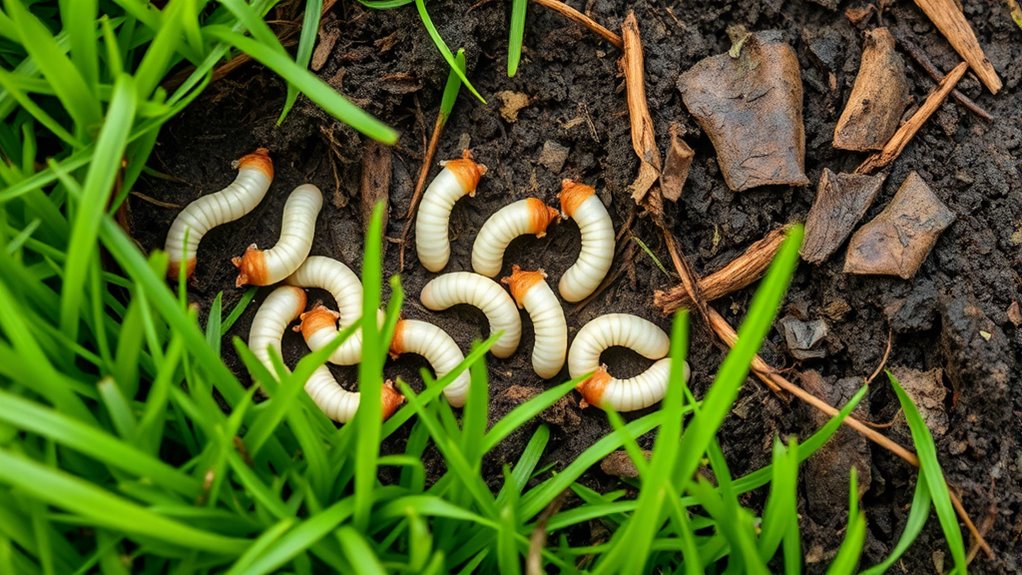
Have you noticed patches of brown, thinning grass in your lawn? It’s a common sign that white grubs might be lurking beneath the surface. These larvae, the immature stage of beetles like Japanese beetles or June bugs, feed on grassroots and roots, causing your turf to weaken and die. If left unchecked, the damage can become extensive, turning lush green areas into unsightly patches. The first step in managing this problem is understanding how to identify these pests and what natural predators and organic control methods you can use to keep them in check.
White grubs are easily recognizable once you know what to look for. They’re C-shaped, creamy-white with brown heads, and typically measure about half to one inch long. You might notice them when you pull up a section of soil or lift a patch of dead grass. Usually, they’re found in the top six inches of soil, where they feed on the roots. An easy way to confirm their presence is to dig into the affected area and sift through the soil, looking for these grubs curled up beneath the surface. You may also spot birds or skunks digging for them, which is nature’s way of controlling their numbers naturally. Additionally, using soil testing can help determine if grubs are present and at what population level.
White grubs are C-shaped, white with brown heads, and found in the top six inches of soil.
When it comes to organic control methods, encouraging natural predators is highly effective. Birds, such as starlings and blackbirds, love feasting on grubs, so attracting these birds to your yard can help reduce their population. You can do this by installing birdhouses or providing bird feeders. Nematodes, particularly beneficial nematodes like Steinernema feltiae, are microscopic worms that hunt and kill grubs without harming your lawn or environment. You simply apply them to the soil, and they actively seek out and parasitize the larvae. These organic control methods are safe, eco-friendly, and effective, especially when used early in the season before the grubs cause severe damage.
Another organic approach involves cultural practices that make your lawn less inviting to pests. Aerating the soil improves drainage and reduces compacted areas where grubs thrive. Proper fertilization strengthens grass roots, making them more resistant to grub feeding. Additionally, watering deeply but infrequently encourages deep root growth, helping your grass recover from any damage and resisting future infestations. These methods, combined with encouraging natural predators like birds and deploying beneficial nematodes, form a holistic strategy to manage white grubs organically.
Frequently Asked Questions
How Can I Prevent White Grubs From Returning Annually?
To prevent white grubs from returning annually, you should practice good lawn care. Regularly aerate your lawn to improve soil health and reduce grub habitat. Manage mulch properly by avoiding excessive or decaying mulch, which attracts grubs. You can also apply beneficial nematodes or insecticides in early summer when grubs are active. Consistent lawn maintenance disrupts their life cycle and keeps your lawn healthy and grub-free.
Are There Eco-Friendly Methods to Control White Grub Populations?
Imagine your lawn thriving under a natural shield—yes, eco-friendly methods work. You can use biological controls like beneficial nematodes and organic treatments such as milky spore or neem oil to control white grub populations. These methods target grubs without harming beneficial insects or the environment, making them a sustainable choice. Regular application, combined with healthy lawn practices, helps keep your yard free of white grubs naturally.
What Natural Predators Help Manage White Grub Infestations?
You can encourage beneficial insects like nematodes, beetles, and parasitic wasps to naturally control white grub infestations. These predators feed on grub larvae, reducing their numbers organically. Using organic controls such as beneficial nematodes applied to the soil creates a natural barrier against grubs. By fostering a healthy, insect-friendly environment, you help keep grub populations in check without resorting to chemical pesticides.
How Does Soil Type Influence White Grub Infestation Severity?
Soil composition and drainage efficiency directly influence white grub infestation severity. If your soil has high clay content, it retains moisture, creating ideal conditions for grubs to thrive. Conversely, well-drained, sandy soils make it harder for grubs to survive by reducing moisture levels. Understanding your soil type helps you identify risk areas and implement effective control measures, ultimately minimizing damage caused by white grubs in your lawn.
Can White Grubs Affect Plants Other Than Lawns?
Yes, white grubs can affect plants beyond lawns, including ornamental plants and other turfgrass. They feed on roots, causing turfgrass damage and weakening plant stability. You might notice wilting, yellowing, or patchy areas in your garden. These pests can also harm shrubs and flowers by disrupting their root systems. To protect your landscape, regularly inspect for grubs and take prompt action if you spot signs of infestation.
Conclusion
By identifying white grubs early, you can stop them from turning your lush lawn into a barren field. Think of these pests as tiny invaders, silently plotting to weaken your turf from beneath. Stay vigilant and act quickly to protect your yard’s health. Remember, ignoring the problem only allows it to grow—like a small spark that can ignite a wildfire. Catch them now, and your lawn will stay vibrant and strong.
